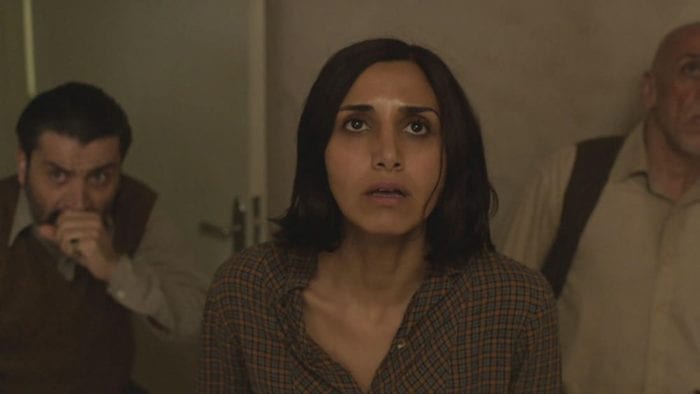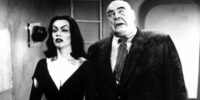Editor’s note: All throughout October, the vibes get spookier and the nights get longer. It’s the perfect time of year to watch horror movies, whether you’re a year-round horror fan or you just like to watch horror flicks to get into the Halloween spirit. This year at Horror Obsessive, for our 31 Horror Classics Revisited series, we’re giving you one recommendation for a classic horror film each day throughout the month of October. What do you think—is this film a horror classic? What other horror films do you consider to be classics, and what films do you make sure you watch each October? Let us know in the comments below!
One of my favorite things about movies is that they give me a glimpse into other people’s experiences. I’m a half-Italian, half-Hispanic American guy in my 30s, but when I watch a movie, I can get a little taste of what it’s like to be someone else from another time or place. It helps me broaden my horizons and grow in my empathy for other people, and in my opinion, few films do this better than Babak Anvari’s 2016 masterpiece Under the Shadow.
The movie is about an Iranian woman named Shideh living in Tehran during the Iran-Iraq War, and after her husband is called into military service, she and her daughter Dorsa become the targets of a malicious spirit known as a djinn. As you can probably guess, Shideh’s experiences are vastly different from my own, but Under the Shadow does such a great job of recreating its historical and cultural setting that it allows me to catch a glimpse of what life must have been like for Iranian women around that time.
In particular, it focuses on the various ways women in that society were (and still are) oppressed, and its supernatural elements are essentially just one big metaphor for those injustices. It’s an absolute masterclass in how to use horror to make a point, so let’s dive into Under the Shadow and see what this modern classic has to say about the oppression of women in 1980s Iran.
The Historical Background

But before we do that, let’s talk a bit about the historical background of this story. Since I live in a very different time and place, I had to do a bit of research to understand just what was going on in Shideh’s world, and I bet most of you are in the same boat. Luckily, Under the Shadow does a great job of giving you most of the information you need to understand its message, so we don’t need to be experts in Iranian history to get it. All we need is a bit of basic knowledge, and the rest will fall into place.
When we Westerners think about Iran, we tend to imagine a country dominated by a very traditional and fundamentalist interpretation of Islam, a land where men rule supreme and women are delegated to second-class status, but it wasn’t always that way. Before the Iranian Revolution of 1979, the Iranian women’s movement had actually made a lot of progress, but when the revolution happened, many of the movement’s gains were scaled back. For example, women’s employment opportunities were severely restricted, men became the unquestioned heads of their households, and all women had to wear a chador in public.
Then, in 1980, Iraq invaded the country, and that kicked off the eight-year-long Iran-Iraq War. Now, as with any war, there’s a ton we could say about this one, but for our purposes here, we only need to note one key point: part of the reason for it was the Iraqi government’s fear that Iran’s new fundamentalist ideology would make its way into their country. Sure, there were other reasons as well, but that’s the only one Under the Shadow is concerned with.
Shideh’s Oppression

With that historical and cultural understanding in place, we’re finally ready to delve into the film itself. Under the Shadow begins with Shideh trying to get back into medical school, but she’s denied because she was involved with leftist political groups during the Iranian Revolution. The movie doesn’t tell us exactly what that means, but since we’re familiar with the story’s historical context, it’s not hard to figure out. Shideh was against the fundamentalist reforms of the revolution, and that must’ve included the revolution’s oppression of women. Unfortunately, her side lost, so now she’s being punished for her political activism in support of women’s rights.
Then, throughout the rest of the film, the oppression women like her face as a result of the revolution comes to the fore again and again. Most notably, she has to wear a chador whenever she’s out in public, and the one time she doesn’t, she’s arrested for it. Luckily, she’s let off with just a warning, but the man who tells her she can go home has some pretty harsh words for her. He tells her, “This behavior is absolutely intolerable. A woman should be scared of exposing herself more than anything else. So, be ashamed. These are not the old times. We have values now. Our men are becoming martyrs to protect these values.”
Every time I hear those lines, I can’t help but get really angry at this guy. Going out in public without a head covering isn’t “intolerable,” and it’s not even close to the worst thing a woman can do. In fact, it’s not a bad thing at all. Sure, if some women want to cover their heads for religious reasons (or for any reason, really), that’s totally fine. It’s their choice, and they have every right to do it. But forcing all women to do it is something else entirely. It relegates them to second-class status, and that’s unacceptable. It’s unjust oppression, plain and simple.
On top of that, there are also a couple of times in Under the Shadow when men showcase a very sexist attitude towards Shideh even though they’re not actively oppressing her. To take just one example, there’s a scene where her husband Iraj has a brief conversation with their landlord, and the landlord asks him to tell Shideh to close the garage door properly when she opens it. Iraj asks him how he knows his wife is leaving it open, and the man says that it must her because the men in the apartment building all close it properly and none of the other women there drive.
Like I said, this landlord isn’t actively oppressing Shideh at that moment, but his attitude towards her is very disparaging. He doesn’t really know if she’s the one who’s been closing the garage door improperly. Rather, he just assumes that the men all do it right, so she must be the problem. And even though that’s not literally oppressive, it’s the kind of attitude that feeds oppression and leads to it. Societies like Iran don’t just restrict women’s rights for no reason. No, they do it because their men look down on women, so even though this landlord isn’t exactly oppressing Shideh, the attitude he exhibits is the root cause of the oppression she faces every day of her life.
The Metaphor of the Djinn

When we turn from the human drama to the horror in Under the Shadow, we’ll find that the djinn mirrors this sexism and oppression in some pretty surprising ways. For example, the spirit gets into Shideh’s apartment building through a gaping hole that was left by an Iraqi missile, and that subtly hints at the connections between the Iran-Iraq War and Iran’s oppression of women.
Remember, one of the reasons for the war was that the Iraqi government didn’t want Iran’s fundamentalist ideology to make its way over to their country, and the man who chewed Shideh out for not wearing a chador even alluded to this when he said that Iranian men were “becoming martys to protect these values.” So even though this part of the story doesn’t forge a direct link between the djinn and the oppression of women, the two are still connected in a somewhat “six degrees of Kevin Bacon” kind of way.
But hands down, the most obvious way this entity mirrors the oppression Shideh faces is its penchant for taking the form of a chador. This happens a couple of times throughout Under the Shadow, and the significance of that visual is impossible to miss. Chadors represent the oppression Iranian women faced in the 1980s, so by taking that form, the djinn is basically smacking us upside the head and telling us that it too is a metaphor for that oppression.
A Modern Classic
Admittedly, even after all that, we’ve still only scratched the surface of Under the Shadow. There’s so much more we could say about this movie, but we’ve gone over enough to make the general point: this film is an excellent example of how to use horror to send a message. It perfectly coordinates its supernatural scares with its human drama to tell a haunting story about the ways Iranian women were oppressed in the 1980s (and, unfortunately, still are today), so it’s way more than just another spooky ghost story. It has something to say, and we’d all do well to take its important themes to heart.



